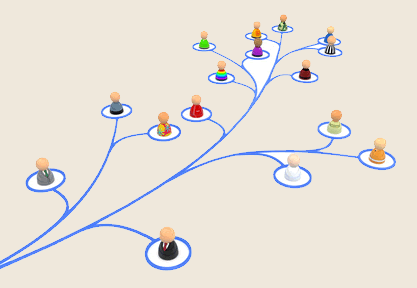Meaning of Grapevine Communication Grapevine is an informal communication network, which ignores formal channels of communication and spreads rumors and gossips at all levels of the business organization. Although every business-organization has its formal channels of communication, the informal channel of communication called grapevine also operates in it. It can be easily found that a large portion of the communication in almost every business house is not formal or pre-planned. The employees communicate through informal channels as they do their jobs. It is neither pre-planned nor deliberately motivated by the management. It is neither written nor documented or recorded. Therefore, it refers to any communication that takes place outside the prescribed and pre-planned channels of formal business communication. It is not set with the lines of organizational hierarchy. As it has no set rules and regulations, it is not confined to a particular direction. It just spreads like a grapevine. Continue reading
Business Communication
As the term suggests, business communication includes all communication that occurs in a business context. A knowledge of business communication presupposes an understanding of both business and communication.
Tools for Effective Communication
The important tools for effective communication are reflective listening, identifying nonverbal cues, and responding with understanding and using effective problem solving techniques. Thus, these techniques of communication are useful to increase your personal effectiveness at home, at work, in the community, in relationships, and with yourself. Opening up yourself to your feelings and the feelings of others requires practice. All forms of life upon the planet Earth were granted one great and wondrous gift: the gift of communication. Instead of being forced to exist in solitude, this gift allows interaction, a sharing of feelings. Humans are especially fortunate because they have developed many ways to use their gift. These include music, dance, art, theater, literature, gestures, the written word, and word of mouth. The creation of different ways to communicate does not mean we can sit back and take our gift for granted. When we were infants, all we needed Continue reading
Non-Verbal Communication – Meaning and Types
Non-verbal communication or most commonly known as body language is the unspoken language of the body which is shown through our bodies to show our true intentions and hints of our feelings to the people whom we are conversing with. When we are conversing with others verbally our bodies simultaneously give out and receive signals which are transmitted by our bodies. This signal’s consists of the gestures we make, how we sit, the intonation and speed of how we talk, the distance we stand when talking and the amount of eye-contact we make while conversing. All this transmits vital non-verbal messages of oneself to another. These non-verbal messages still get across to the people around even when we are silent. The verbal message and body language very frequently contradicts which leaves the listener to choose which one to believe. Usually they will choose the body language. This is the reason Continue reading
Importance of Communication
Communication in its simplest sense involve two or more persons who come together to share, to dialogue and to commune, or just to be together for a festival or family gathering. Dreaming, talking with someone, arguing in a discussion, speaking in public, reading a newspaper, watching TV etc. are all different kinds of communication that we are engaged in every day. Communication is thus not so much an act or even a process but rather social and cultural ‘togetherness’. Communication can be with oneself, god, and nature and with the people in our environment. Interaction, interchange, transaction, dialogue, sharing, communion, and commonness are ideas that crop up in any attempt to define the term communication. Communication is important both for an individual and also for the society. A person’s need for communication is as strong and as basic as the need to eat, sleep, and love. Communication is the requirement Continue reading
Relationship Between Verbal and Non-Verbal Communication
The communication process made of a message being sent and perceived by the others. The message may be verbal or non-verbal. Communication means talking, making friends, interacting with people, having relationships either private life relationships or work related. Communicating with others is essential in leading a normal life. We all communicate in our own way but we need to learn how to do it effectively. Communication has two types, there is verbal communication and non-verbal communication. The verbal is includes oral communication mean that through words and writing. Verbal communication is divided into written and oral communication. The oral communication refers to speaking words in the communication process. Oral communication can be face-to-face communication or a conversation over the phone or on the Messenger chat over the Internet. Spoken conversations or dialogues are affecting by voice modulation, volume and even the speed and clarity of speaking. The Another type of Continue reading
The Importance of Non-Verbal Communication
Non-verbal communication refers to all those messages excluding spoken words. Those messages are body language such as gesture, facial expressions, eye contact and body posture. For instance, smile on our friends face on seeing us, before they utter even a greeting word, when we go to meet them after long time indicates that he or she is happy to see us. Touch is another cue of non-verbal communications. It helps in indicating a person’s feelings or expressions, closeness, and illustrates characteristics of that person. A firm and stiff handshake or warm and lovely hug signify obviously different than a loose one. Never the less, the sound, pitch, tone and volume of our voice while we are communicating can also be referred as forms of non-verbal communication. Voice use intonation, tone and vocally produced sounds. We use the pitch of voice to differentiate whether the sentence is a command, or advice Continue reading

